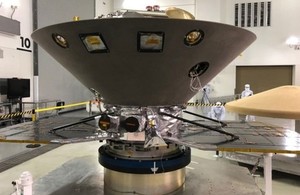Earthquakes on Mars
A new mission to Mars, supported by the UK Space Agency, is due to launch today. InSight will be the first to study the heart of the Red Planet.

InSight undergoes final preparations at the Vandenberg Air Force Base in Central California, ahead of its launch Credit: NASA
A new mission to Mars involving UK science will be the first to study the heart of the Red Planet and measure ‘Marsquakes’ from its surface.
The NASA InSight mission, which stands for Interior Exploration using Seismic Investigations, Geodesy and Heat Transport, is due to launch from California aboard a United Launch Alliance Atlas V rocket at 12.05pm (BST) today (Saturday 5 May).
The InSight Lander will use cutting-edge instruments to delve beneath the surface and investigate the interior of Mars to improve our understanding of how such planets formed. It will also study tectonic activity and meteorite impacts, both of which could provide valuable knowledge about these events on Earth.
The UK Space Agency has invested £4 million in one of the key instruments onboard; the short period Seismometer (SEIS-SP). This will be on the surface of Mars to measure seismic waves from Marsquakes. Scientists expect to detect anywhere between a dozen and a hundred of these tremors up to 6.0 on the Richter scale over the course of two years.
Sam Gyimah, Science Minister, said:
The UK is playing an important role in this exciting mission to unlock the deepest secrets of our nearest neighbour in the solar system. An instrument that started life in a London university laboratory will end it on the surface of Mars detecting quakes and meteor strikes for the first time.
It’s a great example of the importance of international collaboration and our work with the space sector as part of our Industrial Strategy, to ensure the UK remains at the forefront of pioneering science and exploration.
Prof Tom Pike from Imperial College London is leading a team with Dr Simon Calcutt from Oxford University and support from STFC RAL Space, to the work on SEIS-SP.
Prof Tom Pike said:
It’s been enormously challenging to put together such a small sensor with the performance we need to detect Marsquakes. We’ve had the support of the UK Space Agency, and their considerable patience. Now we finally get to see our microseismometers leave the launch pad, next stop Mars.
The spacecraft is due to arrive on the surface of Mars on 26 November. The mission will conduct six science investigations on and below the surface of Mars to uncover the evolutionary history that shaped all of the rocky planets in the inner solar system.
The UK instrument will work together with seismometers from France, as well as major contributions from Switzerland, Germany and the US. Other instruments on board include RISE, a precision radio tracking of the lander that can determine the direction and motion of the rotation of Mars and the HP3 (Heat Flow and Physical Properties Probe) which will study heat flow by embedding a temperature sensor under the surface of Mars.
The UK space sector is playing a leading role in efforts to explore the solar system with additional collaborative projects including the ExoMars mission which will search for evidence of life on Mars using a rover on the surface and a spacecraft in orbit above it. The rover is designed and built in Britain by Airbus for launch in 2020 and the spacecraft recently returned the first photos from its new orbit showing an ice-filled, Martian crater.
The UK Space Agency, University of Leicester and Airbus are also involved in a mission to the closest planet to the Sun, Mercury, called BepiColombo, which is due to launch later this year.